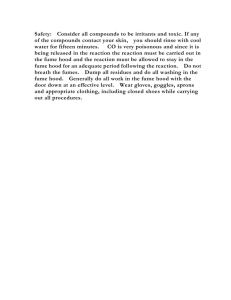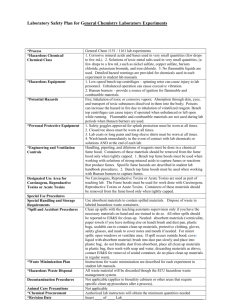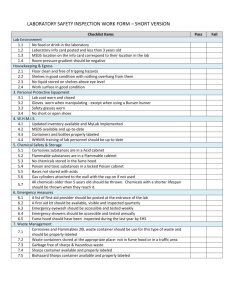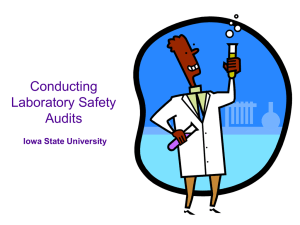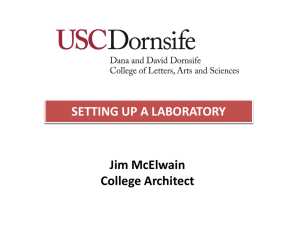15H-8 Laboratory Design - State University Construction Fund
advertisement
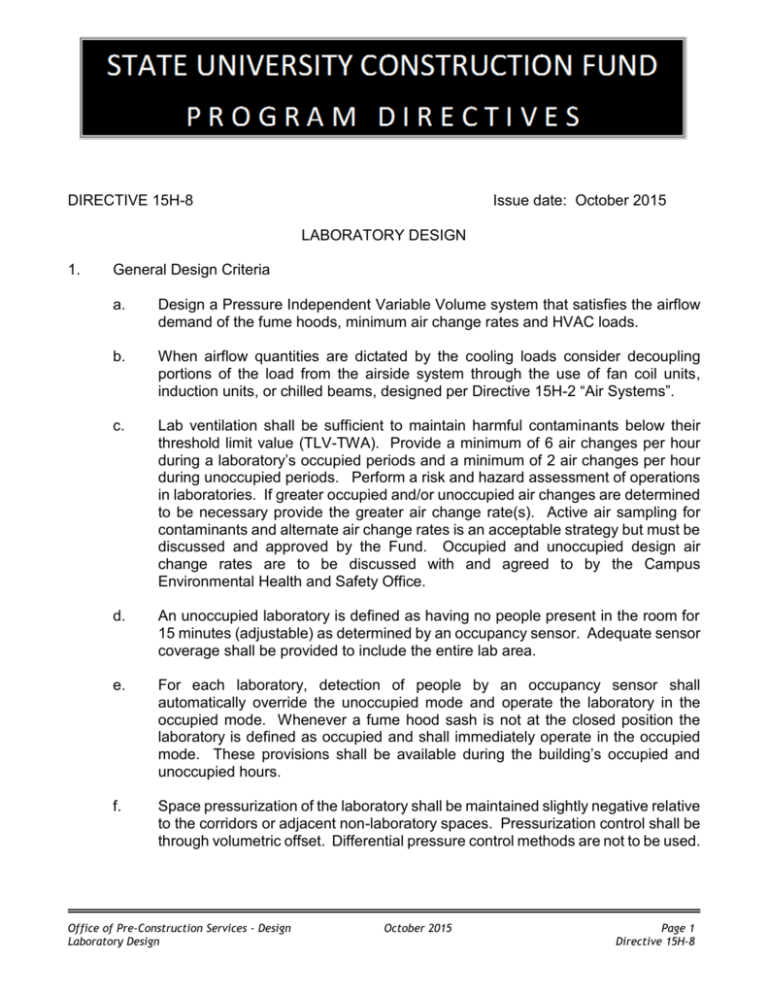
STATE UNIVERSITY C DIRECTIVE 15H-8 Issue date: October 2015 LABORATORY DESIGN 1. General Design Criteria a. Design a Pressure Independent Variable Volume system that satisfies the airflow demand of the fume hoods, minimum air change rates and HVAC loads. b. When airflow quantities are dictated by the cooling loads consider decoupling portions of the load from the airside system through the use of fan coil units, induction units, or chilled beams, designed per Directive 15H-2 “Air Systems”. c. Lab ventilation shall be sufficient to maintain harmful contaminants below their threshold limit value (TLV-TWA). Provide a minimum of 6 air changes per hour during a laboratory’s occupied periods and a minimum of 2 air changes per hour during unoccupied periods. Perform a risk and hazard assessment of operations in laboratories. If greater occupied and/or unoccupied air changes are determined to be necessary provide the greater air change rate(s). Active air sampling for contaminants and alternate air change rates is an acceptable strategy but must be discussed and approved by the Fund. Occupied and unoccupied design air change rates are to be discussed with and agreed to by the Campus Environmental Health and Safety Office. d. An unoccupied laboratory is defined as having no people present in the room for 15 minutes (adjustable) as determined by an occupancy sensor. Adequate sensor coverage shall be provided to include the entire lab area. e. For each laboratory, detection of people by an occupancy sensor shall automatically override the unoccupied mode and operate the laboratory in the occupied mode. Whenever a fume hood sash is not at the closed position the laboratory is defined as occupied and shall immediately operate in the occupied mode. These provisions shall be available during the building’s occupied and unoccupied hours. f. Space pressurization of the laboratory shall be maintained slightly negative relative to the corridors or adjacent non-laboratory spaces. Pressurization control shall be through volumetric offset. Differential pressure control methods are not to be used. Office of Pre-Construction Services - Design Laboratory Design October 2015 Page 1 Directive 15H-8 STATE UNIVERSITY C 2. g. Utilize airflow control devices with a maximum required operating static pressure of 0.3” w.g. h. Provide accessible manual emergency shut off natural gas valve for each laboratory. Coverage and location of valve inside or outside of laboratory is to be coordinated with the Campus. i. Provide manual shut off valve for gas, vacuum, and all other utility services to each laboratory. Location of valve inside or outside of laboratory is to be coordinated with the Campus. j. Design shall control noise of the supply and exhaust air systems (combination of fan generated noise and airflow generated noise) in the laboratory. Systems shall be designed to a maximum NC-40 level. Sound attenuators are acceptable though not preferred. When used, sound attenuators must be constructed of the same material as the ducts, be suitable for the intended uses and be packless. k. Confirm with the Campus the requirements for standby power for laboratory systems including utilities, laboratory exhaust system fans, make-up air units, environmental rooms, refrigerators, space heating/cooling, laboratory plug loads and other systems which the Campus has requested. l. Confirm with the Campus the requirements for redundancy in building utilities such as space heating, space cooling, laboratory exhaust systems, make-up air units, etc. Facilities conducting research are expected to have a higher concern for redundancy than facilities performing primarily teaching activities. Exhaust Systems a. Laboratories shall be exhausted to the outdoors. Energy recovery from exhaust air stream(s) is required. Provide either of the following: 1) Separate exhaust system for the fume hood exhaust and a separate exhaust system for the laboratory general exhaust. Provide an energy recovery wheel for the laboratory general exhaust. For the fume hood exhaust, provide a runaround coil loop system, a fixed plate air-to-air heat exchanger, or other zero cross contamination energy recovery system. 2) A combined fume hood exhaust and laboratory general exhaust system. Provide a runaround coil loop system, a fixed plate air-to-air heat exchanger, or other zero cross contamination energy recovery system. Office of Pre-Construction Services - Design Laboratory Design October 2015 Page 2 Directive 15H-8 STATE UNIVERSITY C 3. b. Provide controls to prevent frosting on energy recovery equipment. c. Laboratory fume hood and general exhaust air streams in fixed plate heat exchangers and energy recovery wheels shall be at a negative pressure with respect to the outside air stream. d. A purge section or other method of preventing cross contamination of the air streams is required for energy recovery wheels. e. For runaround coil loop system and fixed plate air-to-air heat exchanger provide coils and heat exchanger of appropriate material or with appropriate coating for the application. f. Either external or internal bypasses are required for outside air and exhaust air streams for a fixed plate air-to-air heat exchanger allowing for inspection and maintenance of heat exchanger while maintaining system operation. g. Ductwork between fume hood connection and manifolded exhaust ductwork shall be stainless steel with welded joints. Manifolded exhaust ductwork, which is defined to be exhaust from 2 or more laboratories or fume hoods in a common duct, shall be galvanized steel. If the exhaust flow is not compatible with stainless steel or galvanized steel provide the appropriate material for the application. h. Round ductwork for exhaust systems is to be used to the greatest extent possible. i. Exhaust ductwork serving laboratories is to be specifically identified with labeling as laboratory exhaust to differentiate it from other exhaust systems and ductwork in the building. j. Snorkels are to be provided with manual blast gates. Laboratory Layout a. The location of fume hoods, supply diffusers, general exhaust grilles, laboratory furniture and pedestrian traffic should encourage horizontal, laminar flow of supply air into the hood, perpendicular to the hood opening. b. The preferred location of fume hoods is centered on a wall. Do not locate hoods in high traffic areas, corners of rooms, and within 10 feet of doors or doorways. Office of Pre-Construction Services - Design Laboratory Design October 2015 Page 3 Directive 15H-8 STATE UNIVERSITY C 4. c. Provide accessible fume hoods per Code and confirm with the Campus the need for additional accessible and adaptable fume hoods. d. The laboratory module (spacing between islands / benches of casework) and the use of mobile versus fixed benches shall be confirmed with the Campus. e. Provide chemical storage locations as required by the program and approved by the Campus. Utilize ventilated and non-ventilated chemical storage cabinets, based on the hazard of the chemicals, to discourage the practice of using fume hoods as storage cabinets. f. Operable windows should not be provided. For renovation projects containing existing operable windows, provide keyed locks on windows. Maintain required emergency egress through windows as required. g. Fume hood openings should not be located opposite workstations where personnel will spend much of their working day, such as desks or microscope benches. h. Provide non-aspirating supply diffusers separated to the greatest extent possible from the fume hood. Disturbance velocities caused by supply diffusers, operable windows, doors and traffic should not exceed 20% of the hood face velocity. i. Consider using a computer model of the laboratory airflow patterns to validate design when the room airflow is determined by fume hood exhaust requirements. j. Provide an emergency eyewash/shower station(s) in each laboratory in conformance with ANSI / OSHA recommendations. Confirm with the Campus if floor drains, monitoring, etc. are to be provided for emergency eyewash/shower stations. k. Provide portable fire extinguisher(s) in each laboratory. Fume Hoods a. Acceptable fume hood types are constant volume, variable volume or high performance. Provide explanation/justification for each constant volume hood used. Auxiliary make-up air hoods are not to be used. b. Face velocity design criteria for the constant volume or variable volume hood shall be 100 fpm based upon a releasable sash stop position of 18”. Lower face Office of Pre-Construction Services - Design Laboratory Design October 2015 Page 4 Directive 15H-8 STATE UNIVERSITY C velocities for high performance hoods are acceptable provided successful containment performance testing as described in section 5. “Fume Hood Testing” is achieved. 5. 6. c. Desired fume hood features include vertical, horizontal or combination sash, recessed work surface, airfoil sill with air gap, airfoil side posts, accessible valve handles, adjustable baffles, releasable sash stops. All valves and other maintenance points are to be accessible from outside the hood. d. Fume hood air flow monitor shall include digital face velocity display with audible and visual alarm, manual alarm silence, and contact for remote alarm notification. Flow alarm shall occur when face velocity falls below 80% of design face velocity. Fume Hood Testing a. All fume hoods shall be field tested per ASHRAE Standard 110 “Method of Testing Performance of Laboratory Fume Hoods” Velocity Measurement and Smoke Visualization tests. b. ASHRAE Standard 110 “Containment Performance Testing” shall be done in the field on 100% of high performance fume hoods and for 25% of standard hoods. The standard hoods to be tested will be selected during construction. Successfully passing the containment performance testing will be achieved with a control level for 5-minute average tests at each location of 0.10 ppm or less for “as installed” (AI) when conducted at a generation rate of 4 L/m. Laboratory Exhaust System Fans a. Utilize a laboratory exhaust fan with integral pressure controlled bypass. b. Fans shall be AMCA Type B spark resistant and constructed of materials or coated with corrosion resistant materials suitable for the application. c. Locate fans outside the building at the point of final discharge. Fans shall be the last element of the system so that all ductwork within the building is under negative pressure. d. Provide an N+1 arrangement for fans. e. Equip fans with variable frequency drives to provide soft start and aid in smooth transitioning in lead/lag changeover and starting or stopping fans. Variable Office of Pre-Construction Services - Design Laboratory Design October 2015 Page 5 Directive 15H-8 STATE UNIVERSITY C frequency drives are not to be used for capacity control to meet varying exhaust demands. They are only to be used to gradually bring fans up to their respective constant speed operation. f. 7. 8. Discharge stack shall be directed vertically upwards. Exhaust Air Re-entrainment Analysis a. On Laboratory building projects a separate airflow study is required of the laboratory exhaust systems to assess the impacts of the exhaust airflow on the project building and surrounding buildings. An airflow/re-entrainment study using either computational modeling (CFD) and/or physical (wind tunnel) modeling will be required for new buildings and existing ventilation system major modifications. b. Select exhaust locations that minimize the potential for exhaust re-entrainment at the building intakes, operable windows, entry ways, and prevent accumulation on roof areas and at exterior gathering areas. c. The laboratory fan(s) performance shall be assessed by the airflow modeling consultant based on a fan selection from the laboratory exhaust system designer. The exhaust fan stack height shall be a minimum of ten feet above the roof and two feet above a surrounding parapet wall or screen enclosure. Laboratory Waste a. Laboratory waste piping and approved dilution or neutralization system(s) shall be provided for all plumbing fixtures where corrosive waste, spent acids, or other harmful chemicals are discharged to the sanitary sewer. Point of use disposal/collection programs are a Campus elected option. b. Exception: Laboratory waste piping and neutralization system(s) may be omitted where all of the following occur: 1) 2) 3) c. The Campus expresses this preference in writing. The local sewer authority agrees. The Campus has protocols for user control of laboratory waste at each source. Refer to Directive 15H-10 “Piping Types and Materials” for specification of piping materials and joint types. If plastic piping materials are intended to be used, an Office of Pre-Construction Services - Design Laboratory Design October 2015 Page 6 Directive 15H-8 STATE UNIVERSITY C analysis of the expected chemicals to be encountered shall be performed and used to select suitable piping material. 9. Specialty Laboratories a. Animal Laboratories and Housing: Animal labs and housing shall be designed in accordance with the latest edition of the: 1) National Resource Council’s, “Guide for the Care and Use of Laboratory Animals.” 2) National Institutes of Health, “Design Requirements Manual for Biomedical Laboratories and Animal Research Facilities.” b. Perchloric Acid: Provide dedicated fume hood, fan, ductwork and wash-down system. Locate fume hood as close to building’s top floor to minimize duct length and avoid horizontal duct runs. Provide positive drainage slope back into the hood for all horizontal ductwork. An integral full length trough shall be provided at the rear of the hood to collect wash-down water. c. Radioisotope: A radioisotope fume hood may be needed if high level labeling or specific radioisotopes such as Iodine or Astatine will be used. A radioisotope fume hood requires a dedicated fan and ductwork. HEPA filters used in the system should be designed and located such that they may be easily maintained and be of the “Bag-in/bag-out” type. d. Acid Digestion: If the hood will be used for acid digestion or used with concentrated acids that are highly corrosive to stainless steel, provide an acid digestion fume hood. The dedicated hood, ductwork, and fan, must be made of fiberglass reinforced plastic or material with similar acid resistance. e. Other Specialty Labs: For labs with specialize equipment (NMRs or other large equipment with special spatial, structural, mechanical and electrical needs) that will be provided by the campus, provide clear documentation of the equipment used as the basis of design. Since the purchase of equipment will most likely occur after construction of the lab begins, review contingencies with the campus during design for addressing the impact (if any) of purchasing equipment that is different from the models used as the basis for design. Office of Pre-Construction Services - Design Laboratory Design October 2015 Page 7 Directive 15H-8 STATE UNIVERSITY C 10. High Purity Water systems (RO) (RO/DI) a. The type of pure water required for a project shall be determined during meetings with the Campus and building users. Pure water systems shall be specified and detailed on the drawings and shall indicate the following criteria. Point of use systems are a Campus elected option, and may be preferred. Project water quality requirements: Resistivity (Meg Ohms cm), Total Organic Carbon (TOC) (ppb), Particulates > 0.2µm (units/mL), Silica (ppb), and Bacteria (cfu/mL) Pure water production rate (gallons/day) Storage tank volume Distribution loop flow: Design velocity (feet/sec), Design flow (gpm), and pump head (ft. or psi) City (well) feed water analysis b. Pure water systems suppliers shall provide testing and a certified report indicating that the equipment is performing as designed. Water samples shall be taken at the pure water system in the mechanical room. c. Refer to Directive 15H-10 “Piping Types and Materials” for specification of piping materials and joint types ***** Office of Pre-Construction Services - Design Laboratory Design October 2015 Page 8 Directive 15H-8

